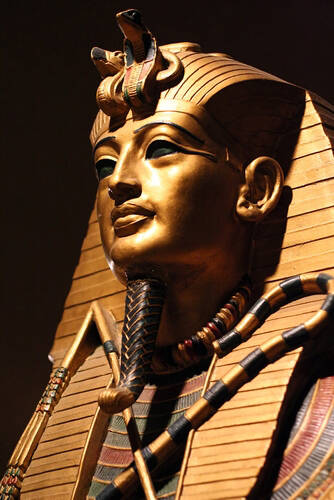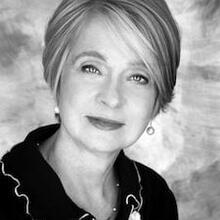A Czech friend suggested to me that we go see “Tutankhamun – His Tomb and His Treasures,” now on exhibition in Prague. The show chronicles the efforts of British archaeologist Howard Carter to discover and unearth the tomb of the 14th century B.C. pharaoh. Replicas of more than 1,000 of the objects found in the tomb are intended to give visitors the experience Carter and his patron, Lord Carnarvon, must have had when they finally stumbled upon the tomb of Tutankhamun after years of digging. Visitors see a reconstruction of the burial chambers and treasury, piled high with the goods Carter recorded finding there in 1922. Based on digital models, the gold coffins, chariots, beds, coffers, musical instruments, cult objects, jewelry, weapons and figures give an effect of overwhelming splendor. There are poignant notes too—the pharaoh’s sandals and walking stick, the golden throne with an image of the young King Tut with his sister wife. Some of the items in the burial chamber and treasury were there to help the pharaoh make the journey to the other world. Others were there for his comfort when he arrived. My friend, age 91, said it was the best exhibit she’d ever seen. Lida is always enthusiastic, which may be a key to her longevity, but it truly was an enthralling show.
By chance, late in the afternoon that same day I visited Karlstejn Castle 40 kilometers outside of Prague. Established in 1348 by Holy Roman Emperor Charles IV to house the crown jewels of the Empire, the castle, perched on a high mountain, has been built and rebuilt over the years. I’d visited it before but had never seen the Chapel of the Holy Cross, the one part of the castle untouched by reconstruction and which can be seen only by appointment. The chapel was the heart of the empire’s treasury. In addition to storing important state documents and the crown jewels, the chapel held the devout Charles IV’s immense collection of relics. It was, said our guide in hushed tones, the most sacred and holy place in all of medieval Europe. Only the emperor and his archbishop could enter the chapel. We normal people were very, very lucky to be able to see this most beautiful chapel today, she said.
A sincere young woman who spoke excellent English, Victoria offered an animated, indeed passionate review of the history of the castle. We climbed to the Chapel of the Holy Cross via the castle’s Marian Chapel, which contains remnants of 16th century frescoes depicting the Book of Revelations. Victoria asked us to cleanse our spirits there before ascending higher to the sumptuous Chapel of the Holy Cross, decorated with semiprecious stones, the ceiling covered in gold inset with ovals of Venetian glass that sparkle like the starry heavens.
Victoria had us rest our eyes in darkness to prepare ourselves for the vision of the Chapel of the Holy Cross. The chapel is decorated with 129 paintings of saints by the well-known Bohemian artist, Master Theodoric, and in the frame of each saint’s painting, at the bottom, there is a small enclosure containing the relics of that saint. Thus it is, Veronica said, that the saint is fully present in the chapel.
Two dazzling exhibitions in one day illustrating the riches and spirituality of two cultures. Both brilliant expressions of belief in God, the afterlife and grace. There were important differences between them, to be sure. A chapel is not a mausoleum, and the Chapel of the Holy Cross is not a shrine to the king who built it but a tribute by him to saintly virtue. But both the chapel and the tomb of Tutenkhamun speak to the wealth and grandeur of rulers, and to their vulnerability as well. Looking at the three coffins of King Tut, one couldn’t help but think about the fugitive preciousness of life, the precariousness of power, the tenuousness of revolution and empires.
King Tut was the end of his family line. The son of Akhenaton, the pharaoh who brought a new monotheistic religion to Egypt, Tutenkhamun brought back the old religion during his reign. He died at age 18 from mysterious causes and left no male heirs to succeed him. After his death, Egypt fell into disorder and war before a general took over as pharaoh. In some ways, we could be talking about today.
Charles IV was more fortunate as ruler. He became king of Bohemia and king of the Romans in 1346. He backed the wrong side in the Hundred Years War, but his chief rival as Holy Roman Emperor, Louis IV of France, died of a stroke while bear hunting, and after being crowned Holy Roman Emperor in 1355 Charles reigned as emperor for 23 years. He made Prague a center of art and culture. The university he founded, Charles University, is the oldest in Central Europe. Every day tourists throng the Charles Bridge he built. His reign is still regarded as the golden age of Bohemia.
The splendor of kings still draws us in a way modern presidential libraries do not. The exhibition I saw in Prague is at least the third major exhibition on Tutenkhamun to tour the world since the tomb was discovered. Visitors gazed in awe at his portrait and the magnificent goods buried with him, all of us luckier than he was.








